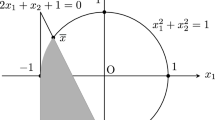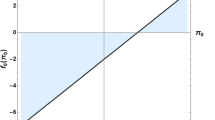Abstract
The cones of directions of constancy are used to derive: new as well as known optimality conditions; weakest constraint qualifications; and regularization techniques, for the convex programming problem. In addition, the “badly behaved set” of constraints, i.e. the set of constraints which causes problems in the Kuhn—Tucker theory, is isolated and a computational procedure for checking whether a feasible point is regular or not is presented.
Similar content being viewed by others
References
J. Abadie, “On the Kuhn—Tucker theorem”, in: J. Abadie, ed.,Nonlinear Programming (North-Holland Publishing Co., Amsterdam, 1967).
R.A. Abrams and L. Kerzner, “A simplified test for optimality”,Journal of Optimization Theory and Applications 25 (1978) 161–170.
K. Arrow, L. Hurwicz and H. Uzawa, “Constraint qualifications in maximization problems”,Naval Research Logistics Quarterly 8 (1961) 175–191.
C.C. Augunwamba, “Optimality conditions: constraint regularization”,Mathematical Programming 13 (1977) 38–48.
M.S. Bazaraa, J.J. Goode and C.M. Shetty, “Constraint qualifications revisited”,Management Science 18 (1972) 567–573.
M.S. Bazaraa, C.M. Shetty, J.J. Goode and M.Z. Nashed, “Nonlinear programming without differentiability in Banach spaces: necessary and sufficient constraint qualification”,Applicable Analysis 5 (1976) 165–173.
A. Ben-Israel, A. Ben-Tal and S. Zlobec, “Characterization of optimality in convex programming without a constraint qualification”,Journal of Optimization Theory and Applications 20 (1976) 417–437.
A. Ben-Israel, A. Ben-Tal and S. Zlobec, “Optimality conditions in convex programming”, The IX International Symposium on Mathematical Programming (Budapest, Hungary, August 1976).
A. Ben-Tal and A. Ben-Israel, “Characterizations of optimality in convex programming: the nondifferentiable case”,Applicable Analysis, to appear.
A. Ben-Tal, L. Kerzner and S. Zlobec, “Optimality conditions for convex semi-infinite programming problems”, Report (1976).
A. Ben-Tal and S. Zlobec, “A new class of feasible direction methods”, Report (1977).
J. Borwein, “Proper efficient points for maximizations with respect to cones”,SIAM Journal of Control and Optimization 15 (1977) 57–63.
J. Borwein and H. Wolkowicz, “Characterizations of optimality without constraint qualification for the abstract convex program. Part I”, Report No. 14, Dalhousie University (Halifax, June 1979).
J. Borwein and H. Wolkowicz, “Characterizations of optimality without constraint qualification for the abstract convex program. Part II: finite dimensional range space”, Report No. 19, Dalhousie University (Halifax, July 1979).
F.H. Clarke, “Nondifferentiable functions in optimization”,Applied Mathematics Notes 2 (Dec. 1976).
V.F. Dem'yanov and V.N. Malozemov,Introduction to minimax, Translated from Russian by D. Louvish (John Wiley & Sons, New York, 1974).
J. Gauvin, “A necessary and sufficient regularity condition to have bounded multipliers in nonconvex programming”,Mathematical Programming 12 (1977) 136–138.
A.M. Geoffrion, “Duality in nonlinear programming: a simplified applications-oriented development”,SIAM Review 13 (1971) 1–37.
I.V. Girsanov,Lectures on mathematical theory of extremum problems, Lecture Notes in Economics and Mathematical Systems, No. 67 (Springer-Verlag, Berlin, 1972).
F.J. Gould and J.W. Tolle, “Geometry of optimality conditions and constraint qualifications”,Mathematical Programming 2 (1972) 1–18.
F.J. Gould and J.W. Tolle, “A necessary and sufficient qualification for constrained optimization”,SIAM Journal of Applied Mathematics 20 (1971) 164–171.
M. Guignard, “Generalized Kuhn—Tucker conditions for mathematical programming problems in a Banach space”,SIAM Journal of Control 7 (1969) 232–241.
R.B. Holmes,A course on optimization and best approximation, Lecture Notes in Mathematics, No. 257 (Springer-Verlag, Berlin, 1972).
B.N. Pshenichnyi,Necessary conditions for an extremum (Marcel Dekker, New York, 1971).
S.M. Robinson, “Stability theory for systems of inequalities. Part I: linear systems”,SIAM Journal of Numerical Analysis 12 (1975) 754–769.
S.M. Robinson, “Stability theory for systems of inequalities. Part II: differentiable nonlinear systems”,SIAM Journal of Numerical Analysis 13 (1976) 497–513.
R.T. Rockafellar,Convex analysis (Princeton University Press, Princeton, NJ, 1970).
R.T. Rockafellar, “Some convex programs whose duals are linearly constrained”, in: J.B. Rosen, O.L. Mangasarian and K. Ritter, eds.,Nonlinear programming (Academic Press, New York, 1970) 293–322.
H. Tuy, “Stability property of a system of inequalities”,Mathematische Operationsforschung und Statistik, Ser. Optimization 8 (1977) 27–39.
H. Wolkowicz, “Calculating the cone of directions of constancy”,Journal of Optimization Theory and Applications 25 (1978) 451–457.
H. Wolkowicz, “Constructive approaches to approximate solutions of operator equations and convex programming”, Ph.D. Thesis, McGill University (Montreal, Que., 1978).
H. Wolkowicz, “Shadow prices for an unstable convex program”, Report No. 15, Dalhousie University (Halifax, May 1979).
S. Zlobec,Mathematical Programming, Lecture notes (McGill University, Montreal, Que., 1977).
S. Zlobec, “Feasible direction methods in the absence of Slater's condition”,Mathematische Operationsforschung und Statistik, Ser. Optimization 9 (1978) 185–196.
G. Zoutendijk,Methods of feasible directions: a study in linear and non-linear programming (Elsevier, New York, 1960).
Author information
Authors and Affiliations
Additional information
This research was supported by the National Research Council of Canada and le Gouvernement du Quebec and is part of the author's Ph.D. Dissertation done at McGill University, Montreal, Que., under the guidance of Professor S. Zlobec.
Rights and permissions
About this article
Cite this article
Wolkowicz, H. Geometry of optimality conditions and constraint qualifications: The convex case. Mathematical Programming 19, 32–60 (1980). https://doi.org/10.1007/BF01581627
Received:
Revised:
Issue Date:
DOI: https://doi.org/10.1007/BF01581627




